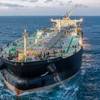INTERTANKO has recorded 60 tanker incidents during the first part of 2004, most of them minor with no resultant pollution or loss of life. This compares to the 130 tanker incidents reported for the whole of 2003.
The biggest pollution incident during the first half of 2004 appeared to be 200 tonnes oil lost from the Everton, which was laden with 80,400 tonnes of crude oil. The tanker caught fire off the Gulf of Oman on 22 March 2004 and was abandoned by its crew. The oil was reported to have been mainly burnt up. One seafarer was reported missing after this incident. The other pollution incidents recorded were very minor.
As in 2003 the most serious tanker incidents in 2004 have involved fire and explosion (F&E). Sadly we have reports of 44 people killed or missing. 21 of these were on board the Singapore-flagged 1982-built chemical tanker Bow Mariner, which exploded and sank early 29 February in 264 ft of water, 50 miles off the Virginia, U.S. coast while en route from New York to Texas City with a cargo of 11,000 tonnes of ethanol.
Elsewhere, seven people were killed after fire swept through the 1993-built suezmax Almudaina when undergoing repair at Singapore's Keppel shipyard. Seven fishermen went missing after their boat was hit by the Chinese 1993-built panamax crude oil tanker Da Qing 93. Three crew members went missing after an engine-room fire on the 1978-built panamax crude oil tanker Fair Mare when departing the Strait of Hormuz. Lastly, the 10,048 dwt 2003-built chemical tanker Panama Serena loaded with benzene, suffered an explosion on board while bunkering at Porto Torres.
The share of F&E was 5-10% of all reported incidents 1978-1989, 6-13% of all reported incidents 1990-1999 and 9-22% of all reported incidents 2000-1H04. Of the F&E type of incidents this year so far, one fire was reported to have started in a cabin, one fire in the electrical system, 5 were engine room fires and one occurred while the vessel was being repaired at a shipyard; of the five explosions, one occurred during repairs, three happened in cargo or ballast tanks and one took place while bunkering.
F&E incidents have increased from 14% (18 incidents) in 2003 to 22% (13 incidents) in the first half of 2004. On the other hand, since 1999/2000 the incidents involving collisions/contact and grounding have reduced every year from 58% in 2000 to 55% in 2001, 54% in 2002, 49% in 2003 and only 41% in the first half of 2004.
This information is mainly based on casualty reports from Informa. Unfortunately the industry lacks information about the root cause of incidents and it is known that there are incidents that are not reported. The performance of tankers has reached such a high level that better information on shipping incidents is now necessary in order to improve performance further. A systematic approach based on knowledge and the likelihood of a specific type of incident occurring is required for the industry to be in a position to implement the measures necessary to avoid such problems.
The trend is, however, clear. The total number of incidents since 2001 appears to have been stabilised at about 120-150 per year, which is less than a third of the average annual number 1990-2000.
ABS, in its March 2004 review and analysis of ship accident databases 1991-2002, found that human error continues to be the dominant factor in maritime accidents. In particular lack of situation awareness and errors in situation assessment were factors in up to 70% of the recorded accidents attributed to human error. Fatigue and task omission are closely related to lack of situation awareness.
ABS also noted that considering the billion tonnes of material shipped on the high seas every year, the millions of miles of wake left behind, and the apparent infrequency of major accidents, shipping might be said to be a rather safe industry, generating a steadily declining trend in marine accidents leading to loss of property, life and environmental damage over the last decade.
Sponsored Content
Maritime leaders unite to tackle ocean plastic with launch of new alliance: the Maritime Association for Clean Seas

ABS Wavesight Advantage™: One Intelligent, Connected Maritime Platform to Transform Complexity into Operational Clarity

Subscribe for
Maritime Reporter E-News
Maritime Reporter E-News is the maritime industry's largest circulation and most authoritative ENews Service, delivered to your Email five times per week









